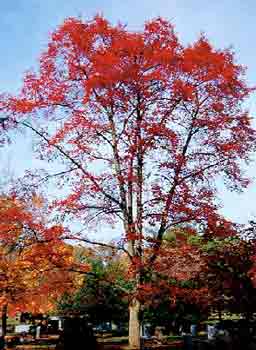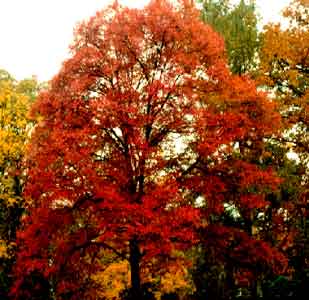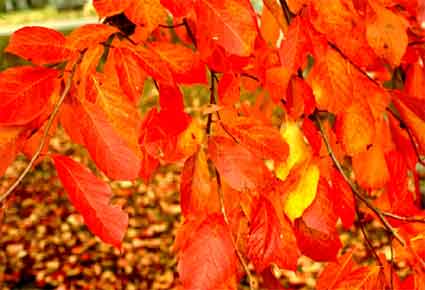Black Gum
Its native range includes southern Ontario to the Central and Eastern United States, and Mexico. In the mountains of North Carolina, Tennessee, Virginia, and Georgia, it has been recently found that a number of the black gum trees have been dying. There was evidence of leaf spots and cankers, but the cause has not been determined.
Nyssa sylvatica
Black gum or black tupelo is a medium-sized, native deciduous tree in the Nyssaceae family. Growing throughout North Carolina in dry upland forests, occasionally in bottomlands, savannas, swamp margins, and upland depressions that are occasionally flooded. It can also be found in the hills and mountains on dry slopes with oaks and hickories. The black gum is grown as an ornamental for its beautiful, scarlet red, fall color and for its shiny, dark green leaves in the summer.
Its native range includes southern Ontario to the Central and Eastern United States, and Mexico. In the mountains of North Carolina, Tennessee, Virginia, and Georgia, it has been recently found that a number of the black gum trees have been dying. There was evidence of leaf spots and cankers, but the cause has not been determined.
The genus name, Nyssa, is derived from the word Nyssa or Nysa and refers to a water nymph from Greek mythology. The specific epithet, sylvatica, means “of the woods.”
The black gum reaches a mature size of 40 to 70 feet tall but typically reaches 20 to 30 feet in cultivation. Trunk diameter is typically 1 to 2 feet but can reach 4 to 5 feet in taller specimens. The tree prefers average, medium to wet soils in full sun. It prefers moist, acidic soils, but is adaptive and tolerates poorly-drained soils and standing water, some drought, and some dry soils, at least in the wild. It tolerates many soil types and moisture conditions, but is slow-growing, reaching about 12 to 15 feet in about ten years, growing faster with a good watering and fertilizer schedule
It has a flowering habit that is dioecious, meaning a male and female tree are required to produce fruit. However, some plants have mostly male flowers while others have mostly female flowers, with most plants having a few perfect flowers. This would account for some plants being loaded with egg-shaped blue-black berries, while others may only have a few berries. Female trees need a male pollinator to set fruit. The nectar from the flowers is sought after by bees and tupelo honey is highly prized.
This tree is an excellent choice to support wildlife in the landscape. However, it should be sited in a permanent location because its long taproot makes it difficult to transplant later. It is tolerant of drought, heat, dry, and wet soils, and is moderately salt tolerant, but it is intolerant to alkaline soils. It withstands wind, ice, and salt spray in coastal locations.
Black gum is a good street tree, specimen, and shade tree. The spectacular fall foliage color will add interest to your landscape.
Seasons of Interest:
Bloom: Late Spring to Summer Foliage: Spring, Summer, and Fall Fruits: Late Summer to Fall
Quick ID Hints:
- deeply furrowed bark
- leaf shape elliptic to obovate, dark green upper surface, pale green undersides
- brilliant fall foliage colors of yellow, orange, purple, and red
- entire margins to Irregular coarse teeth near the tips of some leaves
- branches held more or less 90 degrees to the main stem
- bluish-black drupes from September to October
- chambered pith
- vascular bundles in the leaf scar
Insects, Diseases, or Other Plant Problems: Leaf miners and scale are occasional insect pests. It has some susceptibility to leaf spots, cankers, and rust.
VIDEO created by Grant L. Thompson for “Trees, Shrubs, and Woody Vines for Landscaping” a plant identification course offered by the Department of Horticulture at Iowa State University.
- Afterburner® (‘David Odom’)
Upright pyramid, 35′ tall 20′ wide, bright red fall color that stays longer - ‘Autumn Cascades’
Female, weeping, orange-red fall color, blue-black fruit - Fire Starter® (‘JFS-Red’)
Narrow oval, upright, 35′ tall, 18′ wide, early bright red fall color - ‘Green Gable’
Upright branching, red fall color - ‘Miss Scarlet’
Female, red fall color, abundant blue fruits - ‘Red Rage’
Bright red fall color, little leaf spot. - ‘Red Splyndor’
Red fall color - ‘Sheri’s Cloud’
Variegated foliage - ‘Snow Flurries’
- ‘Sparkler’
- Swamp Tupelo
Nyssa sylvatica v biflora – true swamp species found with cypress. Narrow leaves, deeply ridged seeds. - var. biflora
Swamp tupelo, adapted to poor draining soils - ‘Wildfire’
New growth bronze-red - ‘Zydeco Twist’
Contorted growth




































- Afterburner® (‘David Odom’)
Upright pyramid, 35′ tall 20′ wide, bright red fall color that stays longer - ‘Autumn Cascades’
Female, weeping, orange-red fall color, blue-black fruit - Fire Starter® (‘JFS-Red’)
Narrow oval, upright, 35′ tall, 18′ wide, early bright red fall color - ‘Green Gable’
Upright branching, red fall color - ‘Miss Scarlet’
Female, red fall color, abundant blue fruits - ‘Red Rage’
Bright red fall color, little leaf spot. - ‘Red Splyndor’
Red fall color - ‘Sheri’s Cloud’
Variegated foliage - ‘Snow Flurries’
- ‘Sparkler’
- Swamp Tupelo
Nyssa sylvatica v biflora – true swamp species found with cypress. Narrow leaves, deeply ridged seeds. - var. biflora
Swamp tupelo, adapted to poor draining soils - ‘Wildfire’
New growth bronze-red - ‘Zydeco Twist’
Contorted growth
- Attributes: Genus: Nyssa Species: sylvatica Family: Nyssaceae Uses (Ethnobotany): Wood is tough, cross-grained, hard to work, and warps easily. It is often used for crates, cross ties, rough floors, and pulpwood. Life Cycle: Perennial Woody Recommended Propagation Strategy: Layering Seed Country Or Region Of Origin: Southern Ontario, Central and Eastern United States, and Mexico Distribution: Native: United States–AL, AR, CT, FL, GA, IL KS, KY, LA, ME, MA, MI, MS, MO, NH, NJ, NY, NC, OH, OK, PA, RI, SC, TN, TX, VT, VA, and WI; Canada–Ontario; Mexico–Mexico Central, Mexico Gulf, Mexico Northeast, and Mexico Southeast. Fire Risk Rating: low flammability Wildlife Value: Its young sprouts are eaten by white-tailed deer. The fruits (berries) are enjoyed by thrushes and other songbirds, wild turkeys, black bear, foxes, raccoons and opossums from August through October. It is one of the most important food sources for fall song bird migration. The natural hollows that form in the tree are a refuge for reptiles, tree frogs, bats and other wildlife. The spring flowers are a nectar source for bees. Play Value: Attracts Pollinators Colorful Wildlife Food Source Particularly Resistant To (Insects/Diseases/Other Problems): Resistant to fire. This tree is somewhat resistant to deer damage. Edibility: Fruit can be eaten raw or cooked. Produces a thin sharply acid pulp that is pleasant to roll in the mouth as a masticatory, it is also used in preserves. The honey bees produce from the flowers of this tree is highly prized. Dimensions: Height: 40 ft. 0 in. – 70 ft. 0 in. Width: 20 ft. 8 in. – 35 ft. 6 in.
- Whole Plant Traits: Plant Type: Native Plant Tree Woody Plant Leaf Characteristics: Deciduous Habit/Form: Columnar Irregular Open Pyramidal Rounded Spreading Growth Rate: Medium Maintenance: Low Texture: Medium
- Cultural Conditions: Light: Full sun (6 or more hours of direct sunlight a day) Soil Texture: Clay Loam (Silt) Sand Soil pH: Acid ( <6.0) Neutral (6.0-8.0) Soil Drainage: Good Drainage Moist Occasional Flooding Occasionally Dry Occasionally Wet Available Space To Plant: 12-24 feet 24-60 feet NC Region: Coastal Mountains Piedmont USDA Plant Hardiness Zone: 4a, 4b, 5a, 5b, 6a, 6b, 7a, 7b, 8a, 8b, 9a, 9b
- Fruit: Fruit Color: Black Blue Fruit Value To Gardener: Edible Display/Harvest Time: Fall Summer Fruit Type: Drupe Fruit Length: < 1 inch Fruit Width: < 1 inch Fruit Description: Female trees only. From late summer to fall, the tree produces green drupes that ripen to bluish-black, round to oval, 3/8 to 1/2-inch long, and clustered on stalks up to 1 1/2 inches long. Thin, bitter-smelling flesh surrounds the small, ribbed seeds. The fruits are edible but sour. Birds and small mammals enjoy the drupes.
- Flowers: Flower Color: Green White Flower Inflorescence: Insignificant Umbel Flower Bloom Time: Spring Summer Flower Size: < 1 inch Flower Description: The tree is dioecious and requires male and female plants to produce fruits. The flowers bloom in the spring from May to June; they are not showy. They are small, greenish-yellow, and occur in small clusters. An individual flower is about 1/8 of an inch in diameter.
- Leaves: Woody Plant Leaf Characteristics: Deciduous Leaf Color: Green Leaf Feel: Glossy Leathery Waxy Leaf Value To Gardener: Showy Deciduous Leaf Fall Color: Gold/Yellow Orange Purple/Lavender Red/Burgundy Leaf Type: Simple Leaf Arrangement: Alternate Leaf Shape: Elliptical Obovate Leaf Margin: Dentate Entire Hairs Present: Yes Leaf Length: 3-6 inches Leaf Width: 1-3 inches Leaf Description: Leaves are dark green on the upper surface, paler green on the undersides, 3 to 6 inches long and 1/2 to 3 inches wide, alternate, elliptic to obovate, blunt points, and are pubescent along the veins. Leaves turn yellow, orange, red, or purple in the fall. On sprouts or young trees, the leaves may have a few coarse teeth. The petiole is 0.5 to 1-inch long and reddish
- Bark: Bark Color: Black Dark Brown Light Gray Surface/Attachment: Furrowed Ridges Bark Plate Shape: Rectangle Square Bark Description: The bark is gray, brown to black, and deeply furrowed to create rectangular or square ridges (cobbled). The bark on younger trees is furrowed between flat ridges and matures into quadrangular blocks that are dense, hard, and nearly black.
- Stem: Stem Color: Brown/Copper Gray/Silver Stem Is Aromatic: No Pith (Split Longitudinally): Chambered Stem Description: The twig color is gray to brown. The slender limbs grow at right angles to the trunk.
- Landscape: Landscape Location: Coastal Lawn Naturalized Area Riparian Woodland Landscape Theme: Drought Tolerant Garden Native Garden Nighttime Garden Pollinator Garden Rain Garden Water Garden Design Feature: Shade Tree Specimen Street Tree Attracts: Bees Frogs Pollinators Reptiles Small Mammals Songbirds Specialized Bees Resistance To Challenges: Black Walnut Deer Drought Dry Soil Fire Heat Pollution Salt Wet Soil Wind
Black Gum

Black Gum – Nyssa sylvatica
Tupelo Family (Nyssaceae)
Introduction: From waxy spring foliage and brilliant fall color to beautiful winter form, the black gum shows great ornamental value. It has unique, thick bark that is arranged in six-sided plates. It is striking throughout the year, and as it grows older, its graceful, drooping branches add to the distinct form and beauty of this tree.
Culture: Black gum performs best on moist, well-drained, acidic soil, it adapts to extreme climates, tolerates wet conditions and is resistant to drought. Black gum will not tolerate alkaline soil and may suffer damage from pollution. Although it will grow in full sun or partial shade, fall color is enhanced by sunny conditions. Black gum has few disease or insect problems. The tree should be transplanted in spring either balled-and-burlapped or as a container plant.

Botanical Information

- Native habitat: Dry hills or wet flatlands of the eastern U.S.; a Kentucky native.
- Growth habit: Pyramidal when young, black gum develops an irregular rounded or flat-topped form with age.
- Tree size: This slow-growing tree attains a height of 30 to 50 feet and a width of 20 to 30 feet. Rarely reaches 100 feet in the wild.
- Flower and fruit: Flowers are small and insignificant. The bitter, ½-inch blue-black drupes are favored by wildlife but are not particularly ornamental.
- Leaf: This species’ outstanding feature is its dark, glossy foliage that consistently develops spectacular crimson, purple, yellow or orange fall color.
- Hardiness: Winter hardy to USDA Zone 4.

Additional information:
Of the Nyssaceae family, only the genus Nyssa is native to North America. Fossils of Nyssa’s characteristic ribbed seed reveals the presence of these trees in former geological periods and throughout Europe, Asia and North America. The first Nyssa species described was a swamp-growing type. Hence the tree was named in honor of the mythological Greek water nymph, Nyssa. The specific epithet, sylvatica, means “of the woods.” This species has two common names: black gum, referring to the dark leaves; while tupelo is derived from the Creek Indian name for the tree (ito opilwa), which means “swamp tree”.

Aged black gums begin decaying from the top so trees become shorter as they grow older. Because decay begins in the heartwood, there are many hollow black gum trees in the forest. The hollow trees are cut down and then cut into short sections and used for beehives. Black gum is one of the best honey-producing trees in the world. Because of its twisted grain, black gum cannot be split so it has been somewhat spared by lumbermen. The resilient wood is good for making tool handles.
The national champion black gum (67 feet) is in New Jersey.
Because black gum is difficult to propagate vegetatively, few selections have been made. Because provenance has an effect on fall color display, it is recommended a colorful seedling tree from a local source be chosen.